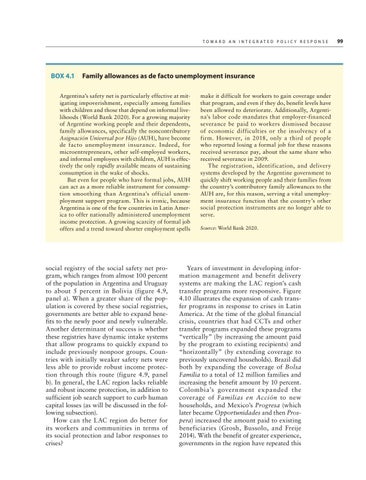T o w a r d a n I n t e g r a t e d P o l i c y R e s p o n s e
BOX 4.1 Family allowances as de facto unemployment insurance Argentina’s safety net is particularly effective at mitigating impoverishment, especially among families with children and those that depend on informal livelihoods (World Bank 2020). For a growing majority of Argentine working people and their dependents, family allowances, specifically the noncontributory Asignación Universal por Hijo (AUH), have become de facto unemployment insurance. Indeed, for microentrepreneurs, other self-employed workers, and informal employees with children, AUH is effectively the only rapidly available means of sustaining consumption in the wake of shocks. But even for people who have formal jobs, AUH can act as a more reliable instrument for consumption smoothing than Argentina’s official unemployment support program. This is ironic, because Argentina is one of the few countries in Latin America to offer nationally administered unemployment income protection. A growing scarcity of formal job offers and a trend toward shorter employment spells
social registry of the social safety net program, which ranges from almost 100 percent of the population in Argentina and Uruguay to about 5 percent in Bolivia (figure 4.9, panel a). When a greater share of the population is covered by these social registries, governments are better able to expand benefits to the newly poor and newly vulnerable. Another determinant of success is whether these registries have dynamic intake systems that allow programs to quickly expand to include previously nonpoor groups. Countries with initially weaker safety nets were less able to provide robust income protection through this route (figure 4.9, panel b). In general, the LAC region lacks reliable and robust income protection, in addition to sufficient job search support to curb human capital losses (as will be discussed in the following subsection). How can the LAC region do better for its workers and communities in terms of its social protection and labor responses to crises?
make it difficult for workers to gain coverage under that program, and even if they do, benefit levels have been allowed to deteriorate. Additionally, Argentina’s labor code mandates that employer-financed severance be paid to workers dismissed because of economic difficulties or the insolvency of a firm. However, in 2018, only a third of people who reported losing a formal job for these reasons received severance pay, about the same share who received severance in 2009. The registration, identification, and delivery systems developed by the Argentine government to quickly shift working people and their families from the country’s contributory family allowances to the AUH are, for this reason, serving a vital unemployment insurance function that the country’s other social protection instruments are no longer able to serve. Source: World Bank 2020.
Years of investment in developing information management and benefit delivery systems are making the LAC region’s cash transfer programs more responsive. Figure 4.10 illustrates the expansion of cash transfer programs in response to crises in Latin America. At the time of the global financial crisis, countries that had CCTs and other transfer programs expanded these programs “vertically” (by increasing the amount paid by the program to existing recipients) and “horizontally” (by extending coverage to previously uncovered households). Brazil did both by expanding the coverage of Bolsa Familia to a total of 12 million families and increasing the benefit amount by 10 percent. Colombia’s government expanded the coverage of Familias en Acción to new households, and Mexico’s Progresa (which later became Opportunidades and then Prospera) increased the amount paid to existing beneficiaries (Grosh, Bussolo, and Freije 2014). With the benefit of greater experience, governments in the region have repeated this
99

